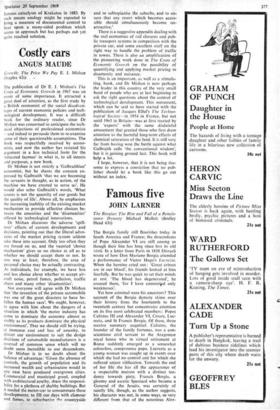Costly cars
ANGUS MAUDE
Growth: The Price We Pay E. J. Mishan (Staples 42s) The publication of Dr E. J. Mishan's The Costs of Economic Growth in 1967 was an event of some importance. It attracted a great deal of attention, as the first study by a British economist of the social disadvan- tages of current economic policies and tech- nological development. It was a difficult book for the ordinary reader, since Dr Mishan was concerned to anticipate the tech- nical objections of professional economists —and indeed to persuade them to re-examine some of their questionable assumptions. The book was respectfully received by econo- mists, and now the author has restated his argument in a less technical form for the 'educated layman' in what is, to all intents and purposes, a new book.
Dr Mishan is not strictly a `Galbraithian' economist, but he shares the concern ex- pressed by Galbraith 'that we are becoming the servants in thought, as in action, of the machine we have created to serve us'. He would also echo Galbraith's words, 'What counts is not the quantity of our goods but the quality of life'. Above all, he emphasises the increasing inability of the existing market mechanism to provide effective choices be- tween the amenities and the 'clisamenities' offered by technological innovations.
Dr Mishan discusses the adverse 'spill- over' effects of current developments and decisions, pointing out.that the liberal advo- cates of the market pricing system seldom take these into account. Only too often they are forced on us, and the vaunted 'choice mechanism' gives us no choice at all as to whether we should accept them or not. In one way at least, therefore, the area of personal choice may be actually contracting. As individuals, for example, we have less and less choice about whether to accept air- craft noise, petrol fumes, pollution, traffic chaos and many other `disamenities'.
Not everyone will agree with Dr Mishan that 'the invention of the private automobile was one of the great disasters to have be- fallen the human race'. We ought, however, to agree with him about the dangers of a situation in which 'the motor industry has come to dominate the economy almost as visibly as its products dominate the physical environment'. That we should still be trying, at immense cost and loss of amenity, to distort our environment to suit the design decisions of automobile manufacturers is a reversal of common sense which will no doubt seem incredible to our descendants.
Dr Mishan is in no doubt about the balance of advantage: 'Given the absence of controls, the growth of population and its increased wealth and urbanisation would in any case have produced overgrown cities. Commercial and municipal greed, coupled with architectural anathy, share the responsi- bility for a plethora of shabby buildings. But it needed the motor-car to consummate these developments; to fill our days with clamour and fumes, to suburbanise the countryside and to subtopianise the suburbs, and to en- sure that any resort which becomes acces- sible should simultaneously become un- attractive.'
There is a suggestive appendix dealing with the real economics of rail closures and pub- lic transport systems in competition with the private car, and some excellent stuff on the right way to handle the problem of traffic in towns. There is also an amplification of the pioneering work done in The Costs of Economic Growth on the possibility of quantifying and applying market pricing to disamenity and nuisance.- This is an important, as well as a stimula- ting, book, and Dr Mishan is now perhaps the leader in this country of the very small band of people who are at last beginning to ask the right questions about the control of technological development. This movement, which can be said to have started with the publication of Jacques Ellul's The Techno- logical Society—in 1954 in France, but not until 1963 in Britain—was at first treated by the 'experts' with the same disdainful amusement that greeted those who first drew attention to the harmful long-term effects of chemical saturation of the land. It is still very far from having won the battle against what Galbraith calls 'the conventional wisdom', but it is gaining ground fast. This book will help a lot.
I hope, however, that it is not being tire- some to express a conviction that no pub- lisher should let a book like this go out without an index.








































 Previous page
Previous page